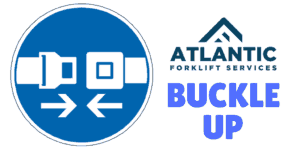 Believe it or not, seatbelts are only recently mandatory safety equipment on a forklift. While, technically, OSHA doesn’t directly mention seatbelts by name they’re firm enough about the wording that we know they’re very serious about the seatbelts. You should be, too.
Believe it or not, seatbelts are only recently mandatory safety equipment on a forklift. While, technically, OSHA doesn’t directly mention seatbelts by name they’re firm enough about the wording that we know they’re very serious about the seatbelts. You should be, too.
Here’s the thing: while a forklift rarely travels at a high enough speed for the driver to be in any real conventional danger there are plenty of other hazards that make a seat belt absolutely necessary. It’s not about the speed.
If a forklift is tipping over, the driver’s natural instinct would be to jump out. That’s exactly the wrong thing to do and a seat belt can efficiently prevent that from happening. It’s critical in a tip-over situation that the operator remains within the roll cage of the forklift. Sobering statistic of the day: according to OSHA, 85 operators are killed every year in the US in forklift accidents. Stay belted in. Stay in the cage.
As we mentioned, seat belt usage isn’t directly mentioned in OSHA’s regs for industrial trucks but that doesn’t mean an OSHA inspector isn’t looking to see if that belt is fastened.
In fact, if an inspector were to cite your employer because you weren’t wearing your seat belt it could result in a fine in the thousands of dollars. No one wants that.
The most common complaint about seat belts from forklift operators is that they are restricting. They’re supposed to be restricting. You know what else is restricting? Getting pinned under a forklift. That’s really restricting. Remind your employees that making it home at the end of the day is much more important than a little discomfort.
As always, our experts can answer any questions you might have and maybe even convince your most stubborn forklift operator that the seat belt is his/her best friend.
